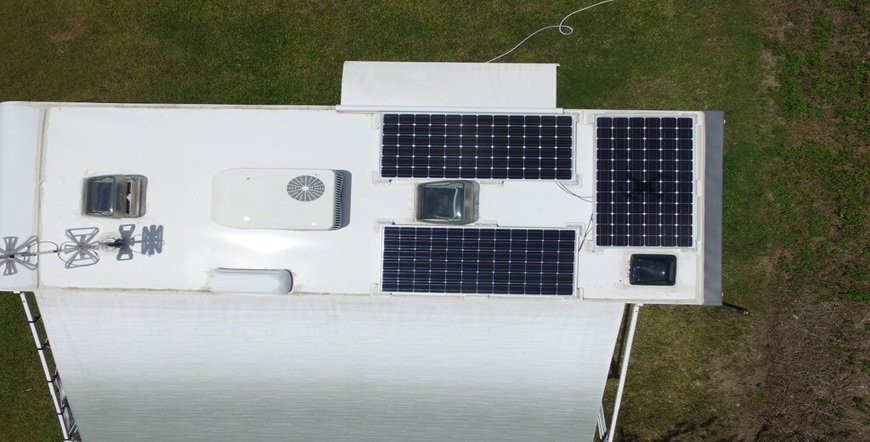- January 31, 2022
- By myAdmin
- In Caravan Solar Panel
- Tags Caravan Solar Panels, Caravan Solar Panels Installation, caravan solar system, Solar System
- 881
- 0

In an age where most of us are concerned about the environment, reducing our carbon footprint is at the top of our minds. Let’s face it; in everyday life, it is impossible not to have a carbon footprint of some sort. Given how vast Australia is, the best option for travel is by car, and when you are travelling in a motorhome or a caravan, fuel becomes a huge cost. It is important for all of us to utilise anything we can to reduce the cost and reliance on fuel and fossil fuels, hence lowering our footprint.
There is a way, however, to reduce your reliance on fossil fuels, by going solar. Solar electric power is the most environmentally friendly option currently available. Solar panels use photovoltaic technology to convert natural light into power. A solar panel will charge your battery whenever the sun shines — even on overcast days when the sun isn’t visible. The ideal source of green energy! In this blog, we take you through the whole process of going solar. How to select the right option, install and maintain it.
Before getting into the details, let us first look at the key components for setting up a caravan solar system.
It is best to start the electrical part of your caravan solar panels installation as early as possible. Ensure the wiring is done before you install any of the components. A proper plan before starting work also ensures that you avoid costly reworks and provide easy access to the system later.
Monocrystalline, polycrystalline, and thin-film amorphous silicon solar cells are the three primary varieties now available. Polycrystalline cells are made up of silicon fragments, whereas monocrystalline cells are formed up of a single silicon crystal. Thin-film panels employ a fundamentally different technology than the other two. It is currently considered new technology, and while less efficient than the other two (particularly in low light), they are predicted to make significant advancements in the coming decade. They are also comparatively less expensive.
According to experts, modest differences in efficiency are less essential than purchasing a reputable brand panel with high build quality.
You also have freestanding panels, which can be moved and used for different applications. Rigid frame panels that are flat and can be roof-mounted optimising exposure to sunlight. Or, flexible panels that are thin, robust, light and low-profile, and can easily be bonded to the roof of a motorhome.
Fortunately, technology is rapidly evolving. It’s becoming simpler now to find high-quality solar panels for your caravan solar system that are not only lightweight and robust but also flexible enough to fit the topography of your van!
You have the option of wiring your solar panels for your caravan solar system in a series or parallel. By connecting all solar panels in a series, they can function as a single unit. This is accomplished by connecting the first solar panel’s positive terminal to the second panel’s negative terminal. By combining them in this manner, the overall voltage provided by the solar array is increased while the amperage remains constant, giving more power.
Each solar panel operates as an individual unit when wired in parallel. This is accomplished by joining all of the solar panels’ positive terminals and all of the panels’ negative terminals. This raises the total amps generated by the array while keeping the voltage constant, giving you longer lasting battery power at the same voltage.
When it comes to fitting solar panels into your caravan’s electrical system, there are a few small components that can make your life easier. When combined with all other electrics, this system can have up to 20 circuits, each requiring a specialised fuse, so it’s ideal to have a fuse box that can house several fuses connected to their circuits in one location.
Install a bus bar to the battery instead of connecting each circuit directly, making maintenance, installation, and future expansion of your system easier. You’ll have to have more fuse holders and terminal connecting points than circuits, and the fuse block and bus bars must be able to carry a current larger than your total.
Similarly, when there are switches for the numerous appliances powered by solar panels for you, switch panels keep things neat.
The cabling in an RV is typically run through the walls and/or ceiling. However, it can also be run beneath the floor or through purpose-built cavities or ducts, usually hidden in cupboards or overhead lockers. Typically, the electrical cabling is placed during the production process and is never referred to again if all goes well.
The Australian/New Zealand Standard for Wiring Rules 3000 and 3001, which apply to “transportable vehicles and buildings,” govern all RV 240V work in Australia.
Your caravanning experience will be radically transformed if you use solar panels. You will get a new degree of independence that you have never had before if you are on solar power. Because of this virtually unlimited source, you will not be relying on mains electricity when travelling. You will be free to go wherever you want, whenever you want!
Also Read: Tips For Modern Caravan Restorations


